
Color temperature plays a vital role in all lights and functions. We need deeper understanding and research to make better choices. In this article, we will compare in detail the differences between color temperatures, such as 2700K vs. 5000K, which are crucial to making the right lighting choice.
The main difference between 2700K vs. 5000K is the type of light they emit. 2700K emits a warm, yellowish light, ideal for cozy and intimate spaces, while 5000K emits a cool, bluish-white light, suitable for task-oriented areas or workspaces.
In this article, we’ll delve into the science of color temperature, compare 2700K vs. 5000K lights in detail, and provide guidance on choosing the color temperature that best suits your needs.
Understanding Color Temperature
Color temperature, defined as the measure of the color characteristics of light, is expressed in degrees Kelvin (K). This metric signifies the hue of a light source, with warm tones associated with lower Kelvin values and cool tones associated with higher Kelvin values.
The Kelvin Scale: Unraveling the Definition
The Kelvin scale serves as a temperature scale to elucidate the color temperature of light. Commencing at 0K (absolute zero) and lacking an upper limit, this scale is employed in lighting, encompassing color temperatures ranging from 1000K to 10,000K.
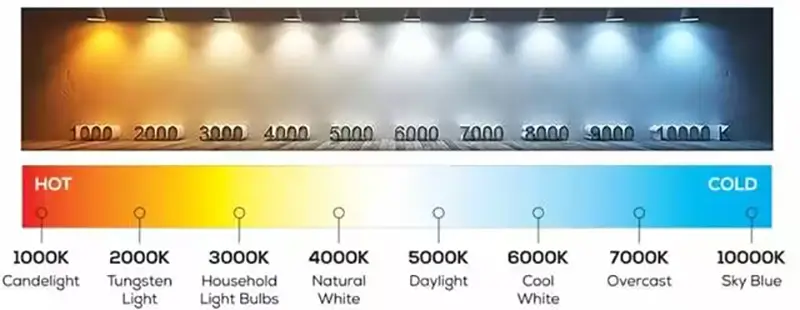
Color Temperature’s Role in Lighting: A Vital Component
The significance of color temperature in lighting design cannot be overstated; it influences the visual impact of a space, the portrayal of colors in objects, and even the mood and behavior of individuals.
What is a 2700K Color Temperature?
2700K color temperature is the warm yellow-white light emitted by the light source. This value is measured in degrees Kelvin (K) and represents the color characteristics of light. At 2700K, the light is on the warmer end of the spectrum, providing a soft, cozy ambience similar to traditional incandescent bulbs.
2700K color temperature is often used in residential lighting, such as living rooms and bedrooms, where a comfortable and warm atmosphere is required. It’s worth noting that lower Kelvin values (such as 2700K) are associated with warmer, reddish hues, while higher Kelvin values tend to produce cooler, bluish hues.
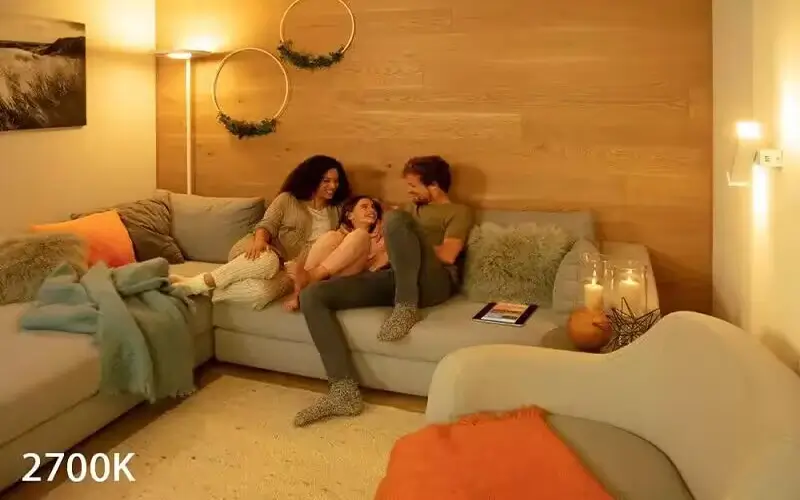
What is the 5000K Color Temperature?
A color temperature of 5000K corresponds to neutral white light. This measurement is expressed in degrees Kelvin (K) and represents the color properties of the light emitted by a light source. At 5000K, the light falls in the middle of the color temperature spectrum, neither too warm nor too cold. This neutral white light is often chosen for applications that require a balance between warm and cool tones.
5000K is often used in a variety of environments, including offices, retail spaces, and residential areas, as it provides clear, natural lighting. It is considered suitable for tasks that require good visibility and color accuracy without the sharpness associated with higher color temperatures.
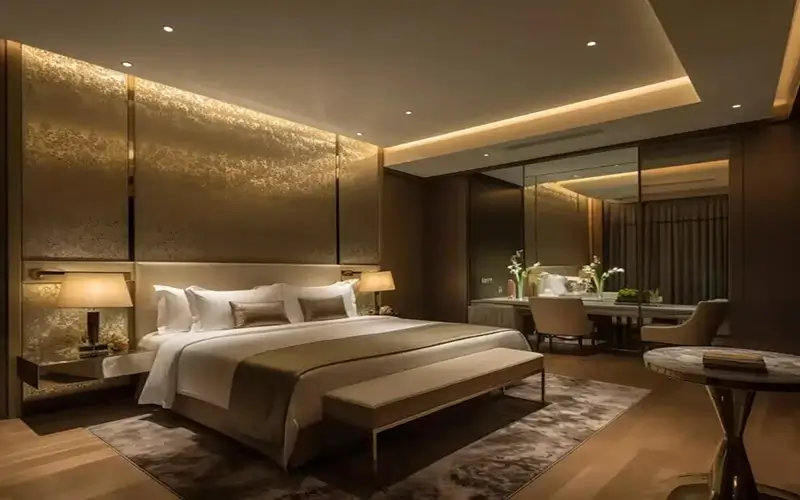
2700K vs. 5000K: What is the Difference?
When comparing 2700K vs. 5000K, it is important to understand their unique characteristics and how they affect various aspects of the environment. Please analyze the difference between 2700K vs. 5000K in terms of color temperature, color, usage, and installation environment.
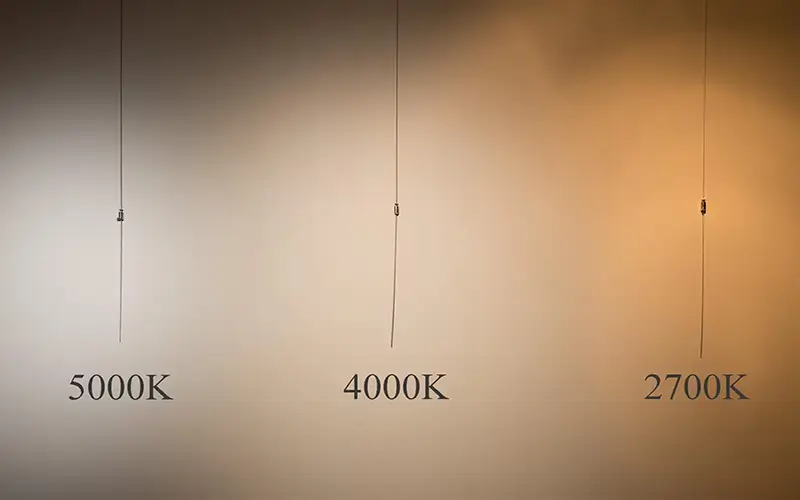
Color temperature
2700K: The light emitted is warm and comfortable. It emits about as much light as a traditional incandescent lamp, creating a relaxing and comfortable atmosphere.
5000K: The light emitted is neutral and balanced. Its main purpose is to imitate natural daylight and provide clear and bright lighting.
Color Appearance: 2700K vs. 5000K
2700K: Produces warmer tones, leaning toward yellows and reds. It mainly creates a comfortable and relaxing atmosphere. Ideal for spaces that require a softer, more intimate atmosphere.
5000K: Provides a more neutral look, closer to pure white. Not too hot or too cold, it is perfect for environments that require precise color rendering, such as workspaces.
Mood and Atmosphere
2700K: Creates a warm, intimate atmosphere. It also affects our mood. Often associated with relaxation and comfort.
5000K: Provides a brighter, more energetic atmosphere, suitable for spaces that require concentration and alertness and where concentration and seriousness are required at all times.
Application: 2700K vs. 5000K
2700K: Commonly used in residential environments to create a warm and pleasant atmosphere. It is also suitable for areas that prefer a relaxed atmosphere, such as restaurants and reception venues.
5000K: Typically chosen for task lighting in workspaces, offices, and areas that require a more dynamic and alert environment. It provides clarity and visibility for detailed tasks.
Residential or Commercial
2700K: Ideal for residential interiors, dining areas, and wherever a warm feel is desired. So we see more 2700K in interior design. Many people will choose between 2700K and 3000K.
5000K: Common in business and professional environments, emphasizing visibility and functionality. primarily an area for commercial and industrial lighting to keep you awake and serious.
Outdoor Lighting: 2700K vs. 5000K
2700K: Ideal for outdoor spaces that prefer soft, warm light, such as decorating a patio or garden area.
5000K: Very suitable for outdoor safety lighting, allowing people to see the road. Because it closely resembles natural daylight, it increases visibility and safety.
Aesthetic and task lighting
2700K: Mainly emphasizes beauty and atmosphere. It’s great for creating visually appealing environments.
5000K: Focused on task lighting in areas where accuracy is critical, mostly in offices. Provides clarity and reduces eye fatigue.
Personal preference
2700K: Great for those who prefer a softer, more traditional lighting experience. People who like a warm style can choose this color temperature.
5000K: Appeals to individuals who appreciate clear, modern lighting aesthetics. People who want a cool style can consider this color temperature.
How to Choose the Right Color Temperature?
Choosing the right lighting color temperature is crucial, so you need to know these in advance. Because it can significantly impact the atmosphere and functionality of a space. The following aspects need to be considered when making this decision:
Purpose of Lighting
Consider the main functions of the installation space. Warm colors (such as 2700K) may be suitable for relaxing environments, while neutral or cool colors (such as 4000K to 5000K) are suitable for task-lit spaces.
Atmosphere
Determine the desired atmosphere yourself. Warm colors will create a warmer and cozy atmosphere, while cool colors will create a modern and energetic feel. This mainly depends on the person’s mood.
Color Rendering
The color rendering index (CRI) of the light source also needs to be considered. A high CRI value (above 90) ensures accurate color representation, which is critical in environments where color accuracy is important, such as art studios or retail spaces. Generally, a light source higher than 90 will be chosen.
Personal Preferences
It’s also important to consider personal preferences. Some people may prefer the warmth of lower Kelvin values, while others may prefer the clarity of higher Kelvin values. Also based on your preferences.
Building Style
Consider the architectural features of the space and evaluate the colors of the artwork and decor in the space. Warm colors can complement traditional or rustic designs, while cool colors can enhance a modern and minimalist aesthetic. The right color temperature can enhance or complement these elements and contribute to the cohesion of the overall design.
In summary, the choice of color temperature involves careful consideration of the function of the space, the desired atmosphere, personal preferences, and the tasks performed within it. By analyzing these aspects, you can make informed decisions that match the specific needs and aesthetics of your environment.
Can We Mix 2700K and 5000K?
Of course, you can choose dual-color LED strips to mix color temperatures (e.g., combine 2700K and 5000K lighting). It can bring many benefits, creating a dynamic and visually appealing environment. Here are some advantages to mixing color temperatures:
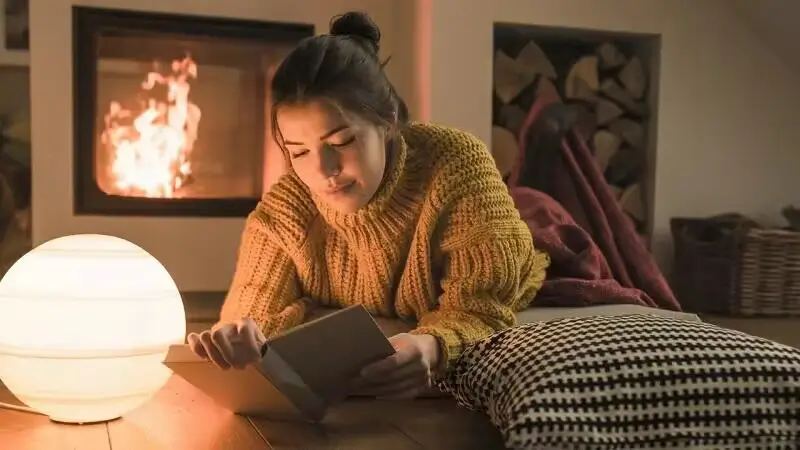
Enhance aesthetics
Combining warm (2700K) and cool (5000K) tones can add depth and visual interest to a space. It creates a layered and visually dynamic environment that enhances the overall aesthetic.
Highlight key areas
Use warm colors, such as 2700K, to accentuate the style and mood of the room. Meanwhile, commercial lighting can use cooler tones (such as 5000K) for a cool style.
Versatility
Different areas within the space may have different functions. We can plan warm colors in leisure areas to create a cozy atmosphere, while cool colors in work spaces can increase alertness and productivity.
Adaptive mood settings
Adjust the mood of your space by controlling the balance between warm and cool lighting. This adaptability allows the creation of different moods and atmospheres depending on the desired setting.
Highlight art and decoration
Warm colors are often suitable for highlighting artwork and decor, adding warmth, and showcasing these elements, while cool colors provide overall illumination.
Create a cohesive design by strategically placing warm and cool lighting elements. This approach can tie various design elements together and unify the overall look of the space.
Overall, blended color temperatures help reduce glare and eye fatigue. Warm colors in relaxation areas and cool colors in task-oriented spaces help provide a more comfortable visual experience.
When combining color temperatures, a balance must be achieved that suits the specific requirements of the space and the desired atmosphere. By experimenting with the position and intensity of warm and cool light sources, a customized and visually appealing lighting design can be achieved.
In conclusion
In summary, the choice between a 2700K vs. a 5000K comes down to desired ambience, functionality, and personal preference. Each color temperature serves a different purpose and meets the specific needs of different spaces and events.
2700K provides a warm, inviting glow, while 5000K provides a neutral white light suitable for tasks and activities that require clarity and precision. Understanding the unique characteristics of each color temperature ensures that lighting choices are consistent with the intended mood and function of the environment.
Don’t be afraid to experiment with different color temperatures and lighting techniques to find the perfect balance for your space. Mixing 2700K and 5000K lighting, utilizing tunable white LED technology, and layering different color temperatures can help you create dynamic and customized lighting solutions that fit your unique needs and preferences.
We are an LED strip light manufacturer that provides high-quality LED light strips that support the customization of different color temperatures according to your project. If you have any needs, please contact us.
FAQs
The main difference is how warm the light is. 2700K is warm and comfortable, similar to traditional incandescent light bulbs. 5000K is a neutral white, similar to natural light and cooler.
It mainly comes down to personal preference, but it also depends on the zoning of the space. If you want to create a warm home atmosphere in the living room, choose 2700K. If you like a modern-style kitchen, then 5000K will be more suitable.
Fortunately, it doesn’t make people feel too warm. But it also depends on where you use it. If it is an area that requires any lighting, 5000K may be more suitable as it provides clearer visibility.
2700K is popular in residential settings, bedrooms, and living rooms to create a warm and inviting atmosphere. 5000K is commonly used in modern homes and workplaces for clear and crisp lighting.
Yes, the same space can also be divided into primary and secondary lighting, or there may be no primary light design. Mixing these color temperatures can create a dynamic and visually appealing environment that enhances the overall lighting scheme.
Yes, 5000K can provide balance and brighten a space without clashing with warm decor.
